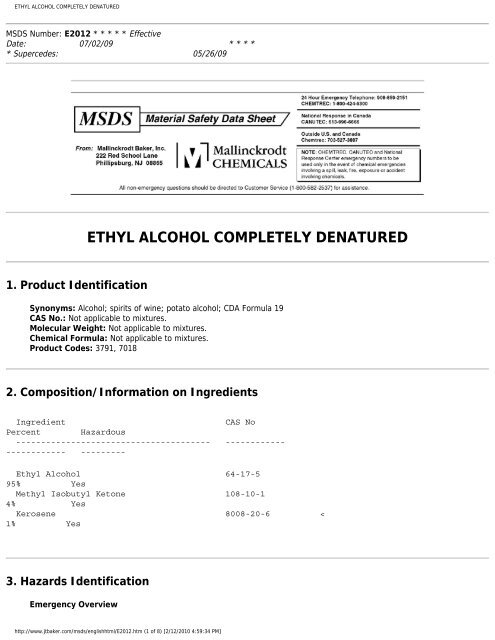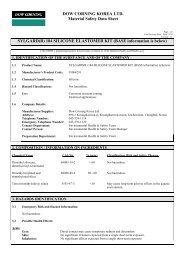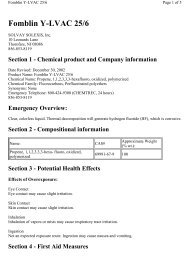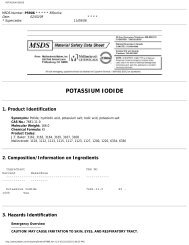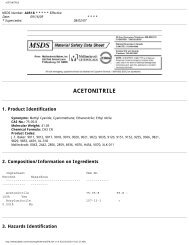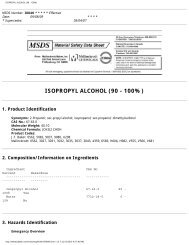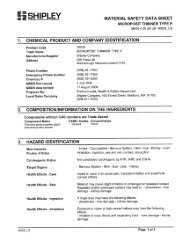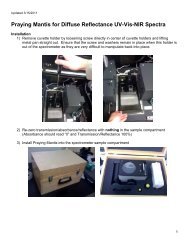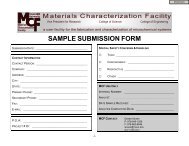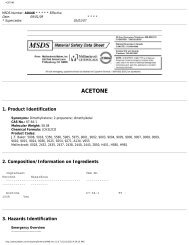ETHYL ALCOHOL COMPLETELY DENATURED
ethyl alcohol completely denatured - Materials Characterization ...
ethyl alcohol completely denatured - Materials Characterization ...
- No tags were found...
You also want an ePaper? Increase the reach of your titles
YUMPU automatically turns print PDFs into web optimized ePapers that Google loves.
<strong>ETHYL</strong> <strong>ALCOHOL</strong> <strong>COMPLETELY</strong> <strong>DENATURED</strong><br />
MSDS Number: E2012 * * * * * Effective<br />
Date: 07/02/09 * * * *<br />
* Supercedes: 05/26/09<br />
<strong>ETHYL</strong> <strong>ALCOHOL</strong> <strong>COMPLETELY</strong> <strong>DENATURED</strong><br />
1. Product Identification<br />
Synonyms: Alcohol; spirits of wine; potato alcohol; CDA Formula 19<br />
CAS No.: Not applicable to mixtures.<br />
Molecular Weight: Not applicable to mixtures.<br />
Chemical Formula: Not applicable to mixtures.<br />
Product Codes: 3791, 7018<br />
2. Composition/Information on Ingredients<br />
Ingredient<br />
CAS No<br />
Percent Hazardous<br />
--------------------------------------- ------------<br />
------------ ---------<br />
Ethyl Alcohol 64-17-5<br />
95% Yes<br />
Methyl Isobutyl Ketone 108-10-1<br />
4% Yes<br />
Kerosene 8008-20-6 <<br />
1% Yes<br />
3. Hazards Identification<br />
Emergency Overview<br />
http://www.jtbaker.com/msds/englishhtml/E2012.htm (1 of 8) [2/12/2010 4:59:34 PM]
<strong>ETHYL</strong> <strong>ALCOHOL</strong> <strong>COMPLETELY</strong> <strong>DENATURED</strong><br />
--------------------------<br />
WARNING! FLAMMABLE LIQUID AND VAPOR. HARMFUL IF SWALLOWED OR INHALED.<br />
CAUSES IRRITATION TO SKIN, EYES AND RESPIRATORY TRACT. AFFECTS THE CENTRAL<br />
NERVOUS SYSTEM, LIVER, KIDNEYS, BLOOD, AND REPRODUCTIVE SYSTEM.<br />
SAF-T-DATA (tm) Ratings (Provided here for your convenience)<br />
-----------------------------------------------------------------------------------------------------------<br />
Health Rating: 2 - Moderate (Life)<br />
Flammability Rating: 3 - Severe (Flammable)<br />
Reactivity Rating: 1 - Slight<br />
Contact Rating: 2 - Moderate<br />
Lab Protective Equip: GOGGLES & SHIELD; LAB COAT & APRON; VENT HOOD; PROPER GLOVES; CLASS<br />
B EXTINGUISHER<br />
Storage Color Code: Red (Flammable)<br />
-----------------------------------------------------------------------------------------------------------<br />
Potential Health Effects<br />
----------------------------------<br />
Inhalation:<br />
Ethanol vapors can produce CNS depression, eye and upper respiratory tract irritation. Symptoms may<br />
include burning sensation, headache, dizziness, tremors, nausea and other symptoms similar to ingestion.<br />
Ingestion:<br />
Dose-related central nervous system depression occurs, ranging from inebriation to anesthesia, narcosis,<br />
coma, respiratory failure, and death in significant exposures. Symptoms include headaches, tremors,<br />
fatigue, hallucinations, distorted perceptions, and convulsions.<br />
Skin Contact:<br />
Contact may result in skin dryness with mild irritation and redness.<br />
Eye Contact:<br />
Ethanol vapors irritate the eyes. Splashes cause burning and stinging sensation with watering of the eyes<br />
and reflex closure of the lids.<br />
Chronic Exposure:<br />
Chronic ethanol exposure may affect the central nervous system, liver, blood and reproductive system. Examples<br />
of chronic effects include physical dependence, malnutrition, neurological effects (e.g., amnesia,<br />
dementia, prolonged sleepiness). Chronic ingestion has been associated with cancers of the esophagus and<br />
liver. Repeated or prolonged skin contact may result in drying of the skin and dermatitis. Combined exposure<br />
to ethanol and certain other chemicals may result in increased toxic effects. Prolonged exposure may affect<br />
the kidneys.<br />
Aggravation of Pre-existing Conditions:<br />
Persons with pre-existing skin disorders, eye problems, liver disease, central nervous system disorders, or<br />
impaired respiratory function may be more susceptible to the effects of the substance.<br />
4. First Aid Measures<br />
Inhalation:<br />
Remove to fresh air. If not breathing, give artificial respiration. If breathing is difficult, give oxygen. Get<br />
medical attention.<br />
Ingestion:<br />
Induce vomiting immediately as directed by medical personnel. Never give anything by mouth to an<br />
unconscious person. Get medical attention.<br />
Skin Contact:<br />
Immediately flush skin with plenty of water for at least 15 minutes. Remove contaminated clothing and shoes.<br />
Get medical attention. Wash clothing before reuse. Thoroughly clean shoes before reuse.<br />
Eye Contact:<br />
Immediately flush eyes with plenty of water for at least 15 minutes, lifting lower and upper eyelids<br />
occasionally. Get medical attention immediately.<br />
http://www.jtbaker.com/msds/englishhtml/E2012.htm (2 of 8) [2/12/2010 4:59:34 PM]
<strong>ETHYL</strong> <strong>ALCOHOL</strong> <strong>COMPLETELY</strong> <strong>DENATURED</strong><br />
5. Fire Fighting Measures<br />
Fire:<br />
Flash point: 13C (55F) CC<br />
Autoignition temperature: 363C (685F)<br />
Flammable limits in air % by volume:<br />
lel: 3.3; uel: 19.0<br />
Listed values are for pure ethanol. Flammable Liquid and Vapor!<br />
Explosion:<br />
Sealed containers may rupture when heated. Above the flash point, explosive vapor-air mixtures may be<br />
formed. Vapor may explode if ignited in an enclosed area. Vapors can flow along surfaces to distant ignition<br />
source and flash back.<br />
Fire Extinguishing Media:<br />
Most appropriate extinguishers are carbon dioxide and alcohol-resistant foam. Use water in flooding quantities<br />
as fog. Water spray may be used to keep fire exposed containers cool. Do not allow water runoff to enter<br />
sewers or waterways.<br />
Special Information:<br />
In the event of a fire, wear full protective clothing and NIOSH-approved self-contained breathing apparatus<br />
with full facepiece operated in the pressure demand or other positive pressure mode.<br />
6. Accidental Release Measures<br />
Ventilate area of leak or spill. Remove all sources of ignition. Wear appropriate personal protective equipment<br />
as specified in Section 8. Isolate hazard area. Keep unnecessary and unprotected personnel from entering.<br />
Contain and recover liquid when possible. Use non-sparking tools and equipment. Collect liquid in an<br />
appropriate container or absorb with an inert material (e. g., vermiculite, dry sand, earth), and place in a<br />
chemical waste container. Do not use combustible materials, such as saw dust. Do not flush to sewer! If a leak<br />
or spill has not ignited, use water spray to disperse the vapors, to protect personnel attempting to stop leak, and<br />
to flush spills away from exposures. US Regulations (CERCLA) require reporting spills and releases to soil,<br />
water and air in excess of reportable quantities. The toll free number for the US Coast Guard National<br />
Response Center is (800) 424-8802.<br />
7. Handling and Storage<br />
Protect against physical damage. Store in a cool, dry well-ventilated location, away from any area where the<br />
fire hazard may be acute. Outside or detached storage is preferred. Separate from incompatibles.<br />
Containers should be bonded and grounded for transfers to avoid static sparks. Storage and use areas should<br />
be No Smoking areas. Use non-sparking type tools and equipment, including explosion proof ventilation.<br />
Containers of this material may be hazardous when empty since they retain product residues (vapors,<br />
liquid); observe all warnings and precautions listed for the product. Do Not attempt to clean empty containers<br />
since residue is difficult to remove. Do not pressurize, cut, weld, braze, solder, drill, grind or expose<br />
such containers to heat, sparks, flame, static electricity or other sources of ignition: they may explode and<br />
cause injury or death.<br />
8. Exposure Controls/Personal Protection<br />
Airborne Exposure Limits:<br />
For Ethyl Alcohol:<br />
- OSHA Permissible Exposure Limit (PEL):<br />
http://www.jtbaker.com/msds/englishhtml/E2012.htm (3 of 8) [2/12/2010 4:59:34 PM]
<strong>ETHYL</strong> <strong>ALCOHOL</strong> <strong>COMPLETELY</strong> <strong>DENATURED</strong><br />
1,000 ppm (TWA)<br />
- ACGIH Threshold Limit Value (TLV):<br />
1,000 ppm (STEL), A3 - Confirmed animal carcinogen with unknown relevance to humans.<br />
Methyl Isobutyl Ketone:<br />
-OSHA Permissible Exposure Limit (PEL):<br />
50 ppm (TWA), 75 (STEL)<br />
-ACGIH Threshold Limit Value (TLV):<br />
50 ppm (TWA), 75 ppm (STEL)<br />
Ventilation System:<br />
A system of local and/or general exhaust is recommended to keep employee exposures below the<br />
Airborne Exposure Limits. Local exhaust ventilation is generally preferred because it can control the emissions<br />
of the contaminant at its source, preventing dispersion of it into the general work area. Please refer to the<br />
ACGIH document, Industrial Ventilation,<br />
A Manual of<br />
Recommended Practices<br />
, most recent edition, for details.<br />
Personal Respirators (NIOSH Approved):<br />
If the exposure limit is exceeded, wear a supplied air, full-facepiece respirator, airlined hood, or full-facepiece<br />
self-contained breathing apparatus.<br />
Skin Protection:<br />
Wear impervious protective clothing, including boots, gloves, lab coat, apron or coveralls, as appropriate,<br />
to prevent skin contact.<br />
Eye Protection:<br />
Use chemical safety goggles and/or a full face shield where splashing is possible. Maintain eye wash fountain<br />
and quick-drench facilities in work area.<br />
9. Physical and Chemical Properties<br />
Appearance:<br />
Clear, colorless liquid.<br />
Odor:<br />
Mild odor.<br />
Solubility:<br />
Infinitely soluble.<br />
Specific Gravity:<br />
0.80<br />
pH:<br />
No information found.<br />
% Volatiles by volume @ 21C (70F):<br />
No information found.<br />
Boiling Point:<br />
78C (172F)<br />
Melting Point:<br />
< -114C (< -173F)<br />
Vapor Density (Air=1):<br />
1.6 @ 19C (66F)<br />
Vapor Pressure (mm Hg):<br />
47 @ 25C (77F)<br />
Evaporation Rate (BuAc=1):<br />
ca. 3.3<br />
10. Stability and Reactivity<br />
Stability:<br />
http://www.jtbaker.com/msds/englishhtml/E2012.htm (4 of 8) [2/12/2010 4:59:34 PM]
<strong>ETHYL</strong> <strong>ALCOHOL</strong> <strong>COMPLETELY</strong> <strong>DENATURED</strong><br />
Stable under ordinary conditions of use and storage. Rapidly absorbs water from air.<br />
Hazardous Decomposition Products:<br />
Carbon dioxide and carbon monoxide may form when heated to decomposition.<br />
Hazardous Polymerization:<br />
Will not occur.<br />
Incompatibilities:<br />
Ethyl Alcohol is incompatible with strong oxidizing agents, perchlorates, aluminum, alkali metals, acetyl<br />
chloride, calcium hypochlorite, chlorine oxides, mercuric nitrate, hydrogen peroxide, nitric acid,<br />
bromine pentafluoride, chromyl chloride, permanganic acid, uranium hexafluoride, acetyl bromide. Ingnites<br />
on contact with phosphorous (III) oxide; platinum; disulfuric acid + nitric acid; potassium tert-butoxide +<br />
acids. Will ignite and then explode on contact with acetic anhydride + sodium hydrogen sulfate. Forms<br />
explosive products in reaction with silver nitrate; ammonia + silver; silver (I) oxide + ammonia or<br />
hydrazine. Methyl Isobutyl Ketone is incompatible with aldehydes, nitric acid, perchloric acid, strong<br />
oxidizers. Violent reaction occurs with potassium-tert-butoxide. May form explosive peroxides in air.<br />
Conditions to Avoid:<br />
Heat, flames, ignition sources and incompatibles.<br />
11. Toxicological Information<br />
Toxicological Data:<br />
For Ethyl Alcohol: LD50 oral rat 7060 mg/kg; LC50 inhalation rat 20,000 ppm/10H; Irritation skin rabbit, std<br />
Draize, 20 mg/24H, moderate; Irritation eye rabbit, std Draize, 500 mg/24H, mild. Investigated as a<br />
tumorigen, mutagen, reproductive effector. For Methyl Isobutyl Ketone: Oral rat LD50: 2080 mg/kg; Skin rabbit<br />
> 20 mL/kg; irritation eye rabbit, Standard Draize, 40 mg severe; investigated as a reproductive effector.<br />
Kerosene irritation data (std Draize): skin, rabbit, 500 mg, severe. Investigated as a tumorigen and mutagen.<br />
Reproductive Toxicity:<br />
Ethanol has been linked to birth defects in humans. Ethanol crosses the placenta and can cause acute<br />
intoxication of the newborn or teratogenic effects, including fetal alcohol syndrome.<br />
--------\Cancer Lists\------------------------------------------------------<br />
---NTP Carcinogen---<br />
Ingredient Known Anticipated IARC Category<br />
------------------------------------ ----- ----------- -------------<br />
Ethyl Alcohol (64-17-5) No No None<br />
Methyl Isobutyl Ketone (108-10-1) No No None<br />
Kerosene (8008-20-6) No No None<br />
12. Ecological Information<br />
Environmental Fate:<br />
Ethyl Alcohol Component:<br />
When released into the soil, this material may biodegrade to a moderate extent. When released into the soil,<br />
this material may leach into groundwater. When released into the soil, this material may evaporate to a<br />
moderate extent. When released into water, this material is expected to readily biodegrade. When released<br />
into water, this material may evaporate to a moderate extent. When released into the air, this material is<br />
expected to be readily degraded by photolysis.<br />
Environmental Toxicity:<br />
Ethyl Alcohol Component:<br />
The LC50/96-hour values for fish are over 100 mg/l.<br />
13. Disposal Considerations<br />
http://www.jtbaker.com/msds/englishhtml/E2012.htm (5 of 8) [2/12/2010 4:59:34 PM]
<strong>ETHYL</strong> <strong>ALCOHOL</strong> <strong>COMPLETELY</strong> <strong>DENATURED</strong><br />
Whatever cannot be saved for recovery or recycling should be handled as hazardous waste and sent to a<br />
RCRA approved waste facility. Processing, use or contamination of this product may change the<br />
waste management options. State and local disposal regulations may differ from federal disposal<br />
regulations. Dispose of container and unused contents in accordance with federal, state and local requirements.<br />
14. Transport Information<br />
Domestic (Land, D.O.T.)<br />
-----------------------<br />
Proper Shipping Name: FLAMMABLE LIQUID, N.O.S. (<strong>ETHYL</strong> <strong>ALCOHOL</strong>, M<strong>ETHYL</strong> ISOBUTYL KETONE)<br />
Hazard Class: 3<br />
UN/NA: UN1993<br />
Packing Group: II<br />
Information reported for product/size: 20L<br />
International (Water, I.M.O.)<br />
-----------------------------<br />
Proper Shipping Name: FLAMMABLE LIQUID, N.O.S. (<strong>ETHYL</strong> <strong>ALCOHOL</strong>, M<strong>ETHYL</strong> ISOBUTYL KETONE)<br />
Hazard Class: 3<br />
UN/NA: UN1993<br />
Packing Group: II<br />
Information reported for product/size: 20L<br />
International (Air, I.C.A.O.)<br />
-----------------------------<br />
Proper Shipping Name: FLAMMABLE LIQUID, N.O.S. (<strong>ETHYL</strong> <strong>ALCOHOL</strong>, M<strong>ETHYL</strong> ISOBUTYL KETONE)<br />
Hazard Class: 3<br />
UN/NA: UN1993<br />
Packing Group: II<br />
Information reported for product/size: 20L<br />
15. Regulatory Information<br />
--------\Chemical Inventory Status - Part 1\---------------------------------<br />
Ingredient TSCA EC Japan Australia<br />
----------------------------------------------- ---- --- ----- ---------<br />
Ethyl Alcohol (64-17-5)<br />
Yes Yes<br />
Yes Yes<br />
Methyl Isobutyl Ketone (108-10-1)<br />
Yes Yes<br />
Yes Yes<br />
Kerosene (8008-20-6)<br />
Yes Yes<br />
No Yes<br />
--------\Chemical Inventory Status - Part 2\---------------------------------<br />
--Canada--<br />
Ingredient Korea DSL NDSL Phil.<br />
----------------------------------------------- ----- --- ---- -----<br />
Ethyl Alcohol (64-17-5) Yes Yes No Yes<br />
Methyl Isobutyl Ketone (108-10-1) Yes Yes<br />
No Yes<br />
Kerosene (8008-20-6) Yes Yes No Yes<br />
--------\Federal, State & International Regulations - Part 1\----------------<br />
http://www.jtbaker.com/msds/englishhtml/E2012.htm (6 of 8) [2/12/2010 4:59:34 PM]
<strong>ETHYL</strong> <strong>ALCOHOL</strong> <strong>COMPLETELY</strong> <strong>DENATURED</strong><br />
-SARA 302- ------SARA 313------<br />
Ingredient RQ TPQ List Chemical Catg.<br />
----------------------------------------- --- ----- ---- --------------<br />
Ethyl Alcohol (64-17-5) No No No No<br />
Methyl Isobutyl Ketone (108-10-1) No No Yes No<br />
Kerosene (8008-20-6) No No No No<br />
--------\Federal, State & International Regulations - Part 2\----------------<br />
-RCRA- -TSCA-<br />
Ingredient CERCLA 261.33 8(d)<br />
----------------------------------------- ------ ------ ------<br />
Ethyl Alcohol (64-17-5) No No No<br />
Methyl Isobutyl Ketone (108-10-1) 5000 U161 No<br />
Kerosene (8008-20-6) No No No<br />
Chemical Weapons Convention: No TSCA 12(b): No CDTA: No<br />
SARA 311/312: Acute: Yes Chronic: Yes Fire: Yes Pressure: No<br />
Reactivity: No<br />
(Mixture / Liquid)<br />
Australian Hazchem Code: 2[S]E<br />
Poison Schedule: None allocated.<br />
WHMIS:<br />
This MSDS has been prepared according to the hazard criteria of the Controlled Products Regulations (CPR)<br />
and the MSDS contains all of the information required by the CPR.<br />
16. Other Information<br />
NFPA Ratings: Health: 2 Flammability: 3 Reactivity: 0<br />
Label Hazard Warning:<br />
WARNING! FLAMMABLE LIQUID AND VAPOR. HARMFUL IF SWALLOWED OR INHALED. CAUSES IRRITATION<br />
TO SKIN, EYES AND RESPIRATORY TRACT. AFFECTS THE CENTRAL NERVOUS SYSTEM, LIVER, KIDNEYS,<br />
BLOOD, AND REPRODUCTIVE SYSTEM.<br />
Label Precautions:<br />
Keep away from heat, sparks and flame.<br />
Keep container closed.<br />
Use only with adequate ventilation.<br />
Avoid breathing vapor.<br />
Avoid contact with eyes, skin and clothing.<br />
Wash thoroughly after handling.<br />
Label First Aid:<br />
If swallowed, induce vomiting immediately as directed by medical personnel. Never give anything by mouth to<br />
an unconscious person. If inhaled, remove to fresh air. If not breathing, give artificial respiration. If breathing<br />
is difficult, give oxygen. In case of contact, immediately flush eyes or skin with plenty of water for at least<br />
15 minutes. Remove contaminated clothing and shoes. Wash clothing before reuse. In all cases, get<br />
medical attention.<br />
Product Use:<br />
Laboratory Reagent.<br />
Revision Information:<br />
MSDS Section(s) changed since last revision of document include: 8.<br />
Disclaimer:<br />
************************************************************************************************<br />
Mallinckrodt Baker, Inc. provides the information contained herein in good faith but makes<br />
no representation as to its comprehensiveness or accuracy. This document is intended only as a<br />
http://www.jtbaker.com/msds/englishhtml/E2012.htm (7 of 8) [2/12/2010 4:59:34 PM]
<strong>ETHYL</strong> <strong>ALCOHOL</strong> <strong>COMPLETELY</strong> <strong>DENATURED</strong><br />
guide to the appropriate precautionary handling of the material by a properly trained person<br />
using this product. Individuals receiving the information must exercise their independent<br />
judgment in determining its appropriateness for a particular purpose. MALLINCKRODT BAKER,<br />
INC. MAKES NO REPRESENTATIONS OR WARRANTIES, EITHER EXPRESS OR IMPLIED,<br />
INCLUDING WITHOUT LIMITATION ANY WARRANTIES OF MERCHANTABILITY, FITNESS FOR<br />
A PARTICULAR PURPOSE WITH RESPECT TO THE INFORMATION SET FORTH HEREIN OR<br />
THE PRODUCT TO WHICH THE INFORMATION REFERS. ACCORDINGLY, MALLINCKRODT BAKER,<br />
INC. WILL NOT BE RESPONSIBLE FOR DAMAGES RESULTING FROM USE OF OR RELIANCE UPON<br />
THIS INFORMATION.<br />
************************************************************************************************<br />
Prepared by: Environmental Health & Safety<br />
Phone Number: (314) 654-1600 (U.S.A.)<br />
http://www.jtbaker.com/msds/englishhtml/E2012.htm (8 of 8) [2/12/2010 4:59:34 PM]


